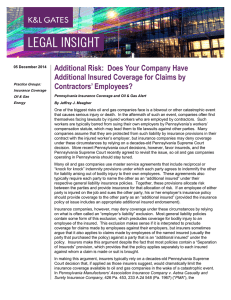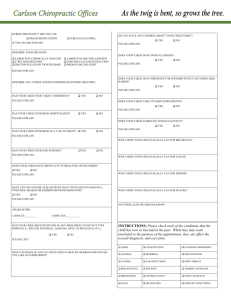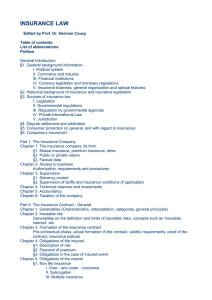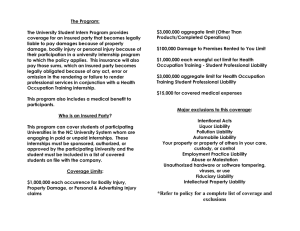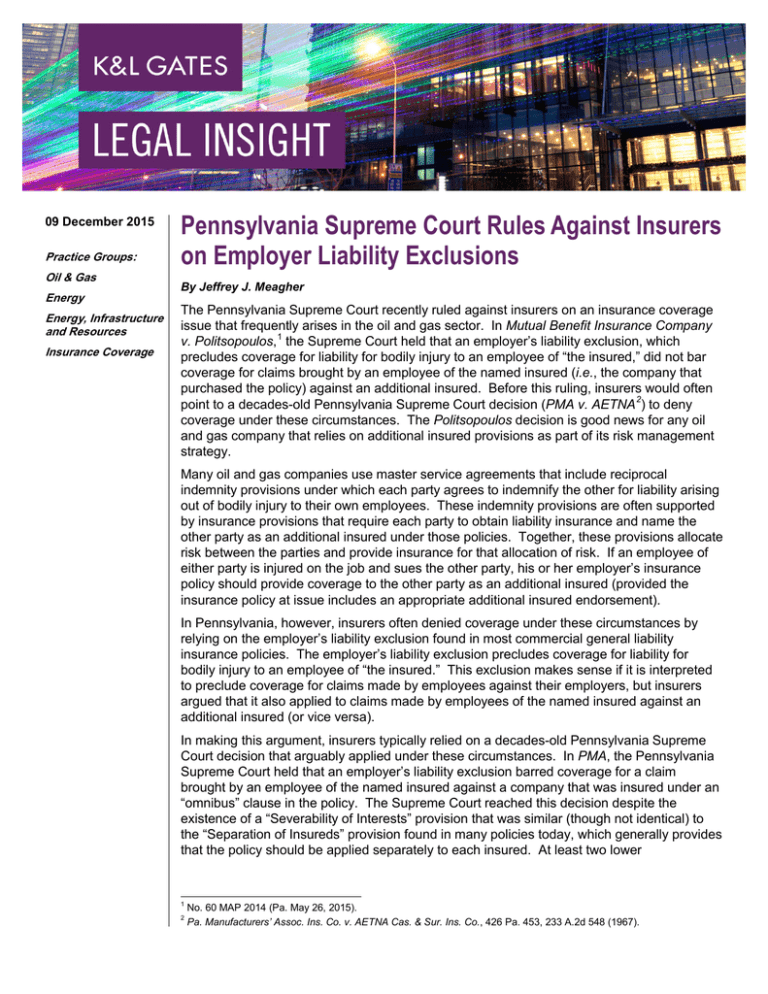
09 December 2015
Practice Groups:
Oil & Gas
Energy
Energy, Infrastructure
and Resources
Insurance Coverage
Pennsylvania Supreme Court Rules Against Insurers
on Employer Liability Exclusions
By Jeffrey J. Meagher
The Pennsylvania Supreme Court recently ruled against insurers on an insurance coverage
issue that frequently arises in the oil and gas sector. In Mutual Benefit Insurance Company
v. Politsopoulos,1 the Supreme Court held that an employer’s liability exclusion, which
precludes coverage for liability for bodily injury to an employee of “the insured,” did not bar
coverage for claims brought by an employee of the named insured (i.e., the company that
purchased the policy) against an additional insured. Before this ruling, insurers would often
point to a decades-old Pennsylvania Supreme Court decision (PMA v. AETNA 2) to deny
coverage under these circumstances. The Politsopoulos decision is good news for any oil
and gas company that relies on additional insured provisions as part of its risk management
strategy.
Many oil and gas companies use master service agreements that include reciprocal
indemnity provisions under which each party agrees to indemnify the other for liability arising
out of bodily injury to their own employees. These indemnity provisions are often supported
by insurance provisions that require each party to obtain liability insurance and name the
other party as an additional insured under those policies. Together, these provisions allocate
risk between the parties and provide insurance for that allocation of risk. If an employee of
either party is injured on the job and sues the other party, his or her employer’s insurance
policy should provide coverage to the other party as an additional insured (provided the
insurance policy at issue includes an appropriate additional insured endorsement).
In Pennsylvania, however, insurers often denied coverage under these circumstances by
relying on the employer’s liability exclusion found in most commercial general liability
insurance policies. The employer’s liability exclusion precludes coverage for liability for
bodily injury to an employee of “the insured.” This exclusion makes sense if it is interpreted
to preclude coverage for claims made by employees against their employers, but insurers
argued that it also applied to claims made by employees of the named insured against an
additional insured (or vice versa).
In making this argument, insurers typically relied on a decades-old Pennsylvania Supreme
Court decision that arguably applied under these circumstances. In PMA, the Pennsylvania
Supreme Court held that an employer’s liability exclusion barred coverage for a claim
brought by an employee of the named insured against a company that was insured under an
“omnibus” clause in the policy. The Supreme Court reached this decision despite the
existence of a “Severability of Interests” provision that was similar (though not identical) to
the “Separation of Insureds” provision found in many policies today, which generally provides
that the policy should be applied separately to each insured. At least two lower
1
2
No. 60 MAP 2014 (Pa. May 26, 2015).
Pa. Manufacturers’ Assoc. Ins. Co. v. AETNA Cas. & Sur. Ins. Co., 426 Pa. 453, 233 A.2d 548 (1967).
Pennsylvania Supreme Court Rules Against Insurers on
Employer Liability Exclusions
Pennsylvania court decisions distinguished PMA, but some federal courts continued to rely
on PMA to rule in favor of insurers on this issue.
The Pennsylvania Supreme Court decided to revisit the issue when it agreed to hear
Politsopoulos. In Politsopoulos, a restaurant employee filed a negligence action against two
property owners who were additional insureds under the restaurant’s liability policy. The
property owners sought defense and indemnification from the restaurant’s insurer, but the
insurer denied coverage, citing the policy’s employer’s liability exclusion. The trial court
judge reluctantly concluded that PMA controlled. The Superior Court reversed the trial
court’s decision and the Supreme Court agreed to hear the appeal. The Supreme Court
concluded that the standard employer’s liability exclusion was ambiguous and, applying the
rule of contract interpretation that ambiguities are construed against the drafter, ruled against
the insurer. In reaching this decision, the Supreme Court focused on the fact that the
exclusion referred to liability for bodily injury to an employee of “the insured” as opposed to
“any insured.” In short, the Supreme Court ruled that “the insured” may be reasonably
interpreted to mean the particular insured against whom the claim is asserted.
In reaching this decision, the Supreme Court brought Pennsylvania in line with most other
jurisdictions that have interpreted the employer’s liability exclusion in this context. The
Politsopoulos decision should mean that insurers can no longer rely on PMA to deny
coverage, but policyholders (and additional insureds) should carefully review the employer’s
liability exclusion in any future policies because insurers may try to draft new policy language
to get around the decision.
Author:
Jeffrey J. Meagher
jeffrey.meagher@klgates.com
+1.412.355.8359
Anchorage
Austin
Fort Worth
Frankfurt
Orange County
Beijing
Berlin
Harrisburg
Palo Alto
Paris
Boston
Hong Kong
Perth
Brisbane
Houston
Pittsburgh
Brussels
London
Portland
Charleston
Los Angeles
Raleigh
Charlotte
Melbourne
Research Triangle Park
Chicago
Miami
Dallas
Milan
San Francisco
Doha
Newark
Dubai
New York
São Paulo
Seattle
Seoul Shanghai Singapore Sydney Taipei Tokyo Warsaw Washington, D.C. Wilmington
K&L Gates comprises approximately 2,000 lawyers globally who practice in fully integrated offices located on five
continents. The firm represents leading multinational corporations, growth and middle-market companies, capital
markets participants and entrepreneurs in every major industry group as well as public sector entities, educational
institutions, philanthropic organizations and individuals. For more information about K&L Gates or its locations,
practices and registrations, visit www.klgates.com.
This publication is for informational purposes and does not contain or convey legal advice. The information herein should not be used or relied upon in
regard to any particular facts or circumstances without first consulting a lawyer.
© 2015 K&L Gates LLP. All Rights Reserved.
2


